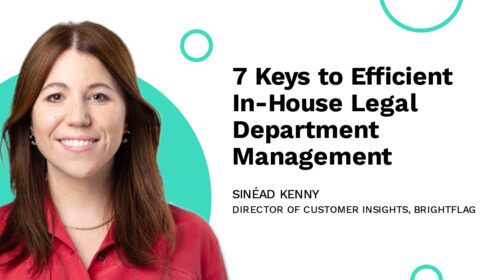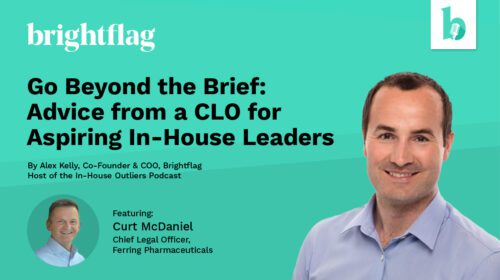How Legal Ops Can Build Their Brand on LinkedIn (And Why You Should)
As the Founder of Law But How? (LBH), I work to transform the way legal teams operate. And part of my role involves coaching legal industry professionals on how to establish a brand on LinkedIn and generate opportunities through visual content.
Why does that matter? LinkedIn content, especially from employees, has a proven effect in improving both your own prospects and brand engagement. By building a LinkedIn brand, you position yourself as an even more valuable asset to both businesses and prospective clients.
For example, the mix of services I personally offer is the direct result of my four-year active presence on social media, and I owe the evolution of my career entirely to social media. My career journey was made possible thanks to my active presence on LinkedIn for years.
This helped me meet new people, connect with my first clients, and realize that new options were available to me. It has been such an eye-opening experience, and I wish this for everyone in our industry who wants to explore their options and reach their full potential.
In short, if you aren’t using LinkedIn as a vehicle to build your reputation, you’re missing out. The good news? If you’re in legal ops, you can still be early to the game.
In this blog post, I’ll walk you through the reasons why LinkedIn branding for legal ops professionals is so important, and why it should be one of your 2026 goals to master it.
Why LinkedIn is the Best Platform for Legal Ops Professional Visibility
LinkedIn’s B2B focus and decision-maker audience
LinkedIn is the go-to platform for B2B transactions. It’s also where your potential audience, including prospective clients needing legal ops support, legal executives looking for talent, and the greater in-house legal community, spend a lot of “professional-minded” time. What I mean by that is: people go on LinkedIn in decision-making mode, open to opportunities.
This sets the platform apart. After all, people aren’t necessarily in the mood to think about legal process improvements when they scroll their Instagram feed. But on LinkedIn, they’re making hiring and buying decisions. They’re looking to network with like-minded peers. And, if you’re creating insightful content, they’re open to becoming part of your legal ops audience. All of which makes mastering LinkedIn branding for legal ops a key part of successfully growing your career.
LinkedIn’s Creator-Friendly Ecosystem: Why Now is the Time
LinkedIn’s organic reach potential
LinkedIn has another significant advantage: Unlike other platforms, it’s fertile ground for cultivating an audience and establishing a profile that drives engagement. The platform is clearly pushing for more creators, and the organic reach is second-to-none. One post can get hundreds of views in a matter of hours, and up to thousands of views once you start growing your following.
The underserved legal ops niche
Here’s the clincher: There are very few people making the most out of the attention, and even fewer in the legal ops space. Legal operations LinkedIn strategy is still in its infancy, making this the perfect place to find your voice, discover your audience, and establish an impactful brand.
In a nutshell: If you’re interested in building a brand on LinkedIn, you’re still early and entering a growing ecosystem. It’s the perfect time to get started.
The Career-Boosting Benefits of Building Your Legal Ops Brand
Building options and career flexibility
One of the key advantages of LinkedIn is the scope it provides to build up more options for yourself. With a well-curated following and content offering, you can move your career in the direction that makes the most sense to you.
For example, I previously worked in-house before transitioning to a different career path. I started my journey as a creator on LinkedIn by posting content about the things I’m nerdy about: designing better contracts that sign faster, evolving the way we think and work in-house, and exploring how visualizing legal information can provide a better user experience and improve the perception of the legal function.
As a result of being active on LinkedIn, I met new people, connected with my first clients, and realized that new options were available to me. It has been such an eye-opening experience, and I wish this for everyone in our industry who wants to explore their options and reach their full potential. And it was made possible thanks to the savvy use of social media.
Social media presence leads to additional opportunities.
Aside from career growth, LinkedIn can also open up numerous other opportunities. Growing a social media presence means that you’re building an audience. This audience can then evolve into a network or community. People will start reaching out to you for various reasons. Events, podcasts, speaking opportunities — you name it.
By investing some time in building out your legal operations LinkedIn strategy, you’re actually building options, both career and otherwise. And options are an insurance policy against the unexpected.
How Legal Ops Professionals Can Build a Brand on LinkedIn: A Strategic Guide
Alright, so now you know why it’s essential to build a LinkedIn brand. Now, how do you go about doing it? What does a strong legal operations LinkedIn strategy actually look like? It’s simpler than you think. Here are three key points to focus on:
Step One: Engage Meaningfully to Build Visibility
The in-house, legal tech, and legal innovation community on LinkedIn may be small, but it’s growing and active. You can easily get started by simply engaging meaningfully with other creators in the space.
Here’s what I mean by meaningful engagement: Provide deep insights in the comments section in a way that keeps the conversation going. Ask questions. Offer advice. Validate with your own examples. Just this single step already sets you off in the right direction by:
Getting you out of the “ghost” side of LinkedIn
LinkedIn “ghosts” are individuals who consume content on LinkedIn without being visible. Once you start posting, you start becoming visible. And other active users begin to notice you.
Getting you noticed
By standing out and providing real insights into a conversation, you put yourself on the radar of multiple people. This includes the author of the post, of course, but also their intended audience. And once they find value in what you have to say, they have the potential to become your audience as well.
Moving the needle from 0 to 1
A big part of the reason people don’t get going with LinkedIn is that it can feel intimidating at first. After all, you’re putting yourself (and your professional reputation) out there for everyone to see. Trust me, that’s a good thing! Doing the above exercise for five minutes a day is a great way to let go of perfectionism and get started, building habits before taking the next leap.
Step Two: Create Strategic Content That Builds Your Legal Ops Brand
Whilst meaningful engagement is excellent as a starting point, a big part of successful LinkedIn branding for legal ops professionals is creating your own spotlight. To do that, you need strategic content.
That means providing meaningful information about the topics you want to be known for the most. Your niche. Provide that, and you start building an audience by giving people valuable insights and a clear-cut reason to follow you.
Here’s the essential part: Be strategic. Think about the things that will generate value for both you and your audience. That means being intentional about what you put out, rather than simply providing value without a clear goal or game plan. Do not be the helpful person who talks about all sorts of things for years and wastes time (this was me for a while).
You can be strategic by focusing on three elements:
- What is it that you want to be known for: CLM, process improvements, e-billing, change management? Select areas where you have extensive knowledge and then focus on creating content that addresses pain points and efficiencies in those specific areas.
- Who is it that you’re targeting: in-house leaders, law firms, legal tech vendors? Ensure you know exactly who you’re targeting and what matters to them.
- How is it that you’re helping people: consulting, providing a product, coaching? Make sure it’s crystal clear what you can offer, and then market that offering with demonstrated expertise.
Once you’ve defined these points, start creating content using the format that feels most comfortable to you (text posts, visuals, videos).
Step Three: Stay Consistent and Play the Long Game
Great things take time to materialize. Don’t give up after three posts because nothing happened. Initially, your posts may not receive a lot of interaction. But over time? That’s when the magic happens, and you might suddenly find yourself fielding more responses and comments than you could have ever anticipated. Have a long-term mindset and practice delayed gratification. You will be surprised to see what happens in the long run.
Final Thoughts: Build Your Legal Ops Brand with Confidence
There is much more that I could unpack here, but I hope this provides a good starting point for LinkedIn branding for legal operations professionals. For more information about how you can get started on social media, and if visual content is something you’d want to explore, you can find me… as you probably already guessed — on LinkedIn!
Brightflag is also doing a tremendous job at highlighting legal creators on LinkedIn. Consider following them to find creators with whom you can start engaging today.
FAQs
Why should legal ops professionals use LinkedIn?
A strong LinkedIn presence opens up a world of possibilities. That includes opportunities for career advancement and the chance to explore new paths or options you didn’t know were available.
What kind of content works best for legal ops professionals?
LinkedIn is a thought leadership space, so your strategy should include insightful pieces that delve deeply into topics you know well. Meaningful engagement with other professionals’ posts is also a good strategy for starting to get your profile noticed.
How do I define my niche as a legal ops professional?
Simple: it’s whatever you know best. Are you a CLM wizard? Or great with e-billing or change management? Start there, with whatever showcases your most impactful skills. And then create content that challenges people to think about how they handle everyday tasks or that helps them solve key pain points.
How long does it take to build a personal brand on LinkedIn?
Effective LinkedIn branding for legal ops professionals doesn’t happen overnight. But if you’re persistent, you will get somewhere. Play the long game, keep engaging, and watch those comments and followers roll in!



